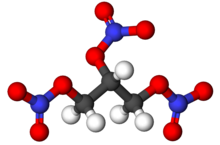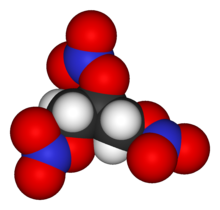നൈട്രോഗ്ലിസറിൻ

| |

| |

| |
| Names | |
|---|---|
| Preferred IUPAC name
Propane-1,2,3-triyl trinitrate | |
Other names
| |
| Identifiers | |
3D model (JSmol)
|
|
| Beilstein Reference | 1802063 |
| ChEBI | |
| ChEMBL | |
| ChemSpider | |
| DrugBank | |
| ECHA InfoCard | 100.000.219 |
| EC Number |
|
| Gmelin Reference | 165859 |
| KEGG | |
| MeSH | {{{value}}} |
PubChem CID
|
|
| UNII | |
| UN number | 0143, 0144, 1204, 3064, 3319 |
CompTox Dashboard (EPA)
|
|
| InChI | |
| SMILES | |
| Properties | |
| C3H5N3O9 | |
| Molar mass | 227.085 g·mol−1 |
| Appearance | Colorless or pale yellow, oily liquid or tetraclinic/orthorhombic crystal |
| സാന്ദ്രത | 1.5931 g/cm−3 |
| ദ്രവണാങ്കം | |
| ക്വഥനാങ്കം | 218 °C (424 °F; 491 K) Explodes |
| Slightly[1] | |
| Solubility | acetone, diethyl ether, benzene, toluene, ethanol[1] |
| log P | 2.154 |
| Structure | |
| |
| |
| Explosive data | |
| Shock sensitivity | High |
| Friction sensitivity | High |
| Detonation velocity | 7,820 m/s |
| RE factor | 1.50 |
| Thermochemistry | |
Std enthalpy of
formation (ΔfH⦵298) |
−370 kJ⋅mol−1 |
Std enthalpy of
combustion (ΔcH⦵298) |
−1.529 MJ⋅mol−1 |
| Pharmacology | |
| C01DA02 (WHO) C05AE01 (WHO) | |
| Routes of administration |
Intravenous, by mouth, under the tongue, topical |
| Pharmacokinetics: | |
| <1% | |
| Liver | |
| 3 min | |
| Legal status |
|
| Hazards | |
| Occupational safety and health (OHS/OSH): | |
Main hazards
|
Explosive, toxic |
| GHS labelling: | |
   
| |
| Danger | |
| H202, H205, H241, H301, H311, H331, H370 | |
| P210, P243, P250, P260, P264, P270, P271, P280, P302+P352, P410 | |
| NFPA 704 (fire diamond) | |
| NIOSH (US health exposure limits): | |
PEL (Permissible)
|
C 0.2 ppm (2 mg/m3) [skin][2] |
Except where otherwise noted, data are given for materials in their standard state (at 25 °C [77 °F], 100 kPa).
| |
നൈട്രോഗ്ലിസറിൻ (NG), നൈട്രോഗ്ലിസറൈൻ, ട്രൈനൈട്രോഗ്ലിസറിൻ (ടിഎൻജി), ട്രൈനൈട്രോഗ്ലിസറൈൻ, നൈട്രോ, ഗ്ലിസറൈൽ ട്രൈനൈട്രേറ്റ് (ജിടിഎൻ), 1,2,3-ട്രൈനൈട്രോക്സിപ്രോപൈൻ എന്നും അറിയപ്പെടുന്നു. സാന്ദ്രതയുള്ള ദ്രാവകാവസ്ഥയിൽ കാണപ്പെടുന്ന ഇവ ഭാരമുള്ളതും, നിറമില്ലാത്തതും, എണ്ണമയമുള്ളതും, സ്ഫോടനസ്വഭാവമുള്ളതുമായ ഭൗതികസ്വഭാവത്തോടുകൂടിയവയാണ്. സാധാരണയായി വെളുത്ത ഫ്യൂമിംഗ് നൈട്രിക് ആസിഡുമായി ഗ്ലിസറോളിനെ ഉചിതമായ വ്യവസ്ഥകൾ പ്രകാരം നൈട്രേഷൻ ചെയ്യുമ്പോൾ നൈട്രിക് ആസിഡ് എസ്റ്റർ ഉണ്ടാകുകയും അതിൽ നിന്നും നൈട്രോഗ്ലിസറിനെ ഉൽപാദിപ്പിക്കുകയും ചെയ്യുന്നു. രാസപരമായി, ഈ വസ്തു ഒരു നൈട്രോ സംയുക്തത്തെക്കാൾ ഓർഗാനിക് നൈട്രേറ്റ് സംയുക്തമാണ്. 1847- ലാണ് ഇത് കണ്ടുപിടിച്ചത്. ഇതിന്റെ പരമ്പരാഗത നാമം തന്നെ നിലനിർത്തിയിട്ടുണ്ട്. സ്ഫോടകവസ്തുക്കളുടെ നിർമ്മാണത്തിൽ നൈട്രോഗ്ലിസറിൻ ഒരു സജീവ ഘടകമാണ്. പ്രധാനമായും ഖനന വ്യവസായത്തിൽ ഉപയോഗിക്കുന്ന ഡൈനാമിറ്റുകളുടെ നിർമ്മാണപ്രവർത്തനത്തിനും തകർക്കുന്നതിനും ഉപയോഗിക്കുന്നു. 1880 മുതൽ, ഇത് സജീവമായ ഒരു ഘടകമായി മിലിട്ടറിയിൽ സൈനികർ ഉപയോഗിക്കുന്നു. നൈട്രോസെല്ലുലോസിൽ ജെലാറ്റിനൈസർ ആയും, ചില സോളിഡ് പ്രൊപ്പല്ലന്റുകളിൽ കോർഡൈറ്റ്, ബലിസ്റ്റിറ്റ് ആയും ഉപയോഗിക്കുന്നു.
റീലോഡറുകൾ ആയി ഉപയോഗിക്കുന്ന ഡബിൾ ബേസ്ഡ് സ്മോക്ക് ലെസ്സ് വെടിമരുന്നിലെ ഒരു പ്രധാന ഘടകം നൈട്രോഗ്ലിസറിൻ ആണ്. റൈഫിൾസ്, പിസ്റ്റളുകൾ, ഷോട്ട്ഗൺ റീലോഡറുകൾ എന്നിവയിൽ ഉപയോഗിക്കുന്ന നൂറുകണക്കിന് പൗഡർ കോമ്പിനേഷനുകളിൽ നൈട്രോസെല്ലുലോസുമായി സംയോജിച്ച് ഉപയോഗിക്കുന്നു.
മരുന്നിൽ 130 വർഷത്തിലധികം നൈട്രോഗ്ലിസറിൻ ഒരു ശക്തമായ വാസോ ഡൈലേറ്ററായി ഉപയോഗിക്കുന്നു. അഞ്ചൈന പെക്ടോറിസ്, ക്രോണിക് ഹാർട്ട് ഫെയിലുവർ തുടങ്ങിയ ഹൃദയസംബന്ധമായ അസുഖങ്ങളുടെ ചികിത്സയ്ക്കുപയോഗിക്കുന്നു. നൈട്രോഗ്ലിസറിൻ ഒരു ശക്തമായ വെനോഡയലേറ്റർ ആയ നൈട്രിക് ഓക്സൈഡായി പരിവർത്തനം ചെയ്യപ്പെടുന്നതിനാലാണ് ഈ പ്രയോജനകരമായ ഇഫക്റ്റുകൾ ലഭിക്കുന്നത്. ഈ പരിവർത്തനത്തിലേക്കുള്ള എൻസൈം 2002 -ൽ മൈറ്റോകോൺട്രിയൽ അൾഡിഹൈഡ് ഡിഹൈഡ്രോജിനേസ് കണ്ടുപിടിച്ചതിനുശേഷമാണ് നൈട്രോഗ്ലിസറിൻ വെനോഡയലേറ്റർ ആയി ഉപയോഗിക്കാൻതുടങ്ങിയത്.[4]സബ് ലിൻഗ്വൽ ഗുളികകൾ ,സ്പ്രേകൾ, പാച്ചുകൾ എന്നീ രൂപത്തിൽ നൈട്രോഗ്ലിസറിൻ ലഭ്യമാണ്.[5]
ചരിത്രം
[തിരുത്തുക]കരിമരുന്നിനേക്കാൾ ശക്തമായ ആദ്യമായി നിർമ്മിച്ച പ്രായോഗിക സ്ഫോടക വസ്തുവാണ് നൈട്രോഗ്ലിസറിൻ.1847- ൽ ടൂറിൻ യൂണിവേഴ്സിറ്റിയിലെ തിയോഫൈൽ-ജൂൾസ് പെലോസിയുടെ കീഴിൽ പ്രവർത്തിച്ചിരുന്ന ഇറ്റാലിയൻ രസതന്ത്രജ്ഞയായ അസ്കാനിയോ സോബ്രെറോ ആണ് ഇത് ആദ്യമായി നിർമ്മിച്ചത്.[6]സോബ്രേറോ ആദ്യം തന്റെ കണ്ടെത്തലിനെ പൈറോഗ്ലിസറിൻ എന്നു വിളിക്കുകയും സ്ഫോടകവസ്തുവായി ഉപയോഗിക്കാമെങ്കിലും അദ്ദേഹം അതിന്റെ ഉപയോഗത്തിനെതിരെ ശക്തമായി താക്കീത് ചെയ്യുകയുണ്ടായി.[7]
അവലംബം
[തിരുത്തുക]- ↑ 1.0 1.1 "Occupational Safety and Health Guideline for Nitroglycerin". Archived from the original on 16 മേയ് 2013. Retrieved 19 ഒക്ടോബർ 2016.
- ↑ NIOSH Pocket Guide to Chemical Hazards. "#0456". National Institute for Occupational Safety and Health (NIOSH).
- ↑ "Hazard Rating Information for NFPA Fire Diamonds". Archived from the original on 17 ഫെബ്രുവരി 2015.
- ↑ Chen, Z; Foster, MW; Zhang, J; Mao, L; Rockman, HA; Kawamoto, T; Kitagawa, K; Nakayama, KI; et al. (2005). "An essential role for mitochondrial aldehyde dehydrogenase in nitroglycerin bioactivation". Proc. Natl. Acad. Sci. USA. 102 (34): 12159–12164. Bibcode:2005PNAS..10212159C. doi:10.1073/pnas.0503723102. PMC 1189320 Freely accessible. PMID 16103363.
- ↑ "Bookmarkable URL intermediate page". web.ebscohost.com. Retrieved 14 April 2018.
- ↑ Sobrero, Ascagne (1847) "Sur plusieur composés détonants produits avec l'acide nitrique et le sucre, la dextrine, la lactine, la mannite et la glycérine" (On several detonating compounds produced with nitric acid and sugar, dextrin, lactose, mannitol, and glycerine), Comptes rendus, 24 : 247–248.
- ↑ Sobrero, Ascanio (1849) "Sopra alcuni nuovi composti fulminanti ottenuti col mezzo dell’azione dell’acido nitrico sulle sostante organiche vegetali" (On some new explosive products obtained by the action of nitric acid on some vegetable organic substances), Memorie della Reale Accademia delle Scienze di Torino, 2nd series, 10 : 195–201. On p. 197, Sobrero names nitroglycerine "pyroglycerine": "Quelle gocciole costituiscono il corpo nuovo di cui descriverò ora le proprietà, e che chiamerò Piroglicerina." (Those drops constitute the new substance whose properties I will now describe, and which I will call "pyroglycerine".)
പുറം കണ്ണികൾ
[തിരുത്തുക]- "Nitroglycerine! Terrible Explosion and Loss of Lives in San Francisco". Central Pacific Railroad Photographic History Museum. Retrieved 2005-03-23. – 1866 Newspaper article
- WebBook page for C3H5N3O9
- CDC - NIOSH Pocket Guide to Chemical Hazards
- The Tallini Tales of Destruction Detailed and horrific stories of the historical use of nitroglycerin-filled torpedoes to restart petroleum wells.
- Dynamite and TNT at The Periodic Table of Videos (University of Nottingham)

